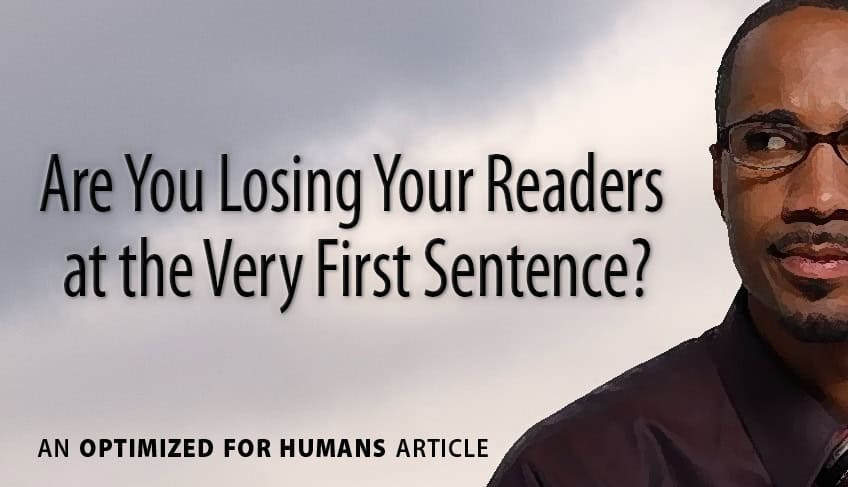
B Y T O M T O R T O R I C I
I’ve always been fascinated by communication – all types of communication. And what I’ve learned is, it’s not just about conveying information. It’s also about engaging people, drawing them in, so they stick around long enough to consider what you have to say.
This is especially important in marketing communications, online and off. People have become so overly inundated with commercial messages that their default response is to glance at something, then move on to something else. If you pay close enough attention, you’d find your own eye continually sliding away from web pages, blog posts, or Sunday newspaper ads that were simply too easy to ignore.
Which is why the core aim of marketing creatives, whether they know it or not, is what has been called “stickiness;” in other words, making it harder for readers to … move on to something else.
The first order of attention-grabbing, of course, is a strong title or headline. As the all-important first thing people see, titles and headlines need to do three things: convey the topic you’re writing about; imply a risk or benefit; and make people curious enough to read the first line of text.
In a world of short attention spans, moving that attention from the last large words of the header, into the first small words of text, is actually a bigger ‘ask’ than we realize. Studies show that only a small percentage of web viewers typically make that leap.
But if you can get them there, the next challenge is to craft a first sentence, an opening line, that disarms them, surprises them even, and makes them curious enough to keep reading.
The most persistently common problem we see are opening sentences that make a vague and obvious statement. There’s no quicker way to lose your reader’s interest; they’ll assume the rest is vague and obvious too, so why bother reading? Instead, use your first few words to quickly pull folks into the action. Intrigue them with an insightful and personally relevant ‘take’ that cuts to the heart of the matter.
Let’s look at some before-and-after examples of opening lines, to see how these types of improvements work in practice.
Pest Control Company
BEFORE:
We know that termites can be a problem for homeowners in any neighborhood.
AFTER:
Are termites happily munching away in your attic at this very minute? How can you be sure?
Commercial Accounting Firm
BEFORE:
Our trained professionals work hard to serve the interests of our clients.
AFTER:
What are the four hidden deductions that most tax advisors miss? Get in touch to find out how much you’ll save.
Landscaping Company
BEFORE:
We’re committed to helping your yard to look its best year-round.
AFTER:
What if your lush, green yard was the envy of your neighbors? There’s nothing wrong with feeling proud of your home.
Interior Designer
BEFORE
I’m Kristen, and I’ve always believed that good interior design is essential.
AFTER
Have you marked the pictures you like in magazines, but aren’t sure how to achieve that look in your home?
Motorhome Manufacturer
BEFORE
This year, we’re introducing additional amenities and features to our complete line of RVs.
AFTER
What would it feel like to be immersed in a mountain forest – but with all the comforts of home?
Did you see any patterns in those examples? You may have noticed that most of the Before lines are ‘about’ the seller, and most of the After lines are ‘about’ the buyer. Shifting from the inward-looking perspective of company insiders to the real-world perspective of potential customers helps put those customers where they belong – in the middle of their own story.
Second, note how often the opening line was changed from a statement to a question. Marketing statements are common and expected, and often come off as superficially boastful. But a direct and relevant question engages the reader, leading them to think about the benefits, the possibilities, and the fact that this vendor ‘gets it.’
Finally, go back and note that an emotional component has been introduced in the After opening lines. This is more important than most marketers realize. Neuroscientists say that humans typically make decisions based on an emotional reaction, then come up with a ‘logical’ rationale later to justify that decision.
In any case, if you don’t spend a fair percentage of your writing time developing a truly compelling opening sentence (and headline of course), it really doesn’t matter what else your page, post or ad says. Because unimpressed readers will have already … moved on to something else.
Share It:
 About the Author: Tom Tortorici is an Atlanta copywriter and web content writer who helps companies make a genuine connection with their audience. His classes and conference presentations have focused on how writing, strategy and design can work together to grab attention and interest even among readers with short attention spans. In addition to working directly with businesses, Tom regularly partners with web designers and marketing agencies.
About the Author: Tom Tortorici is an Atlanta copywriter and web content writer who helps companies make a genuine connection with their audience. His classes and conference presentations have focused on how writing, strategy and design can work together to grab attention and interest even among readers with short attention spans. In addition to working directly with businesses, Tom regularly partners with web designers and marketing agencies.
All Posts/Subscribe >
Info for Businesses >
Info for Designers/Agencies >
Tom Tortorici Inc. | Tom@TomTortorici.com | 770-934-7861 | 3101 Rockaway Rd | Atlanta GA 30341
